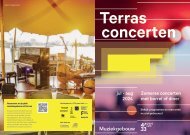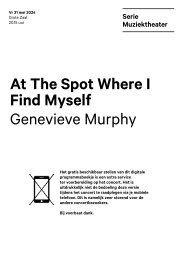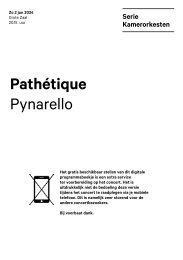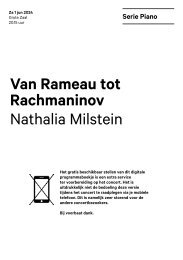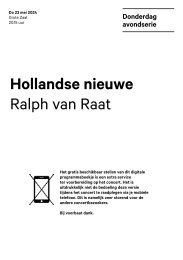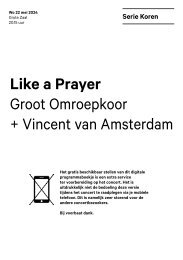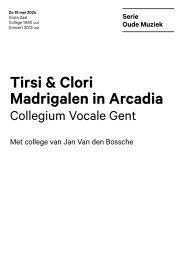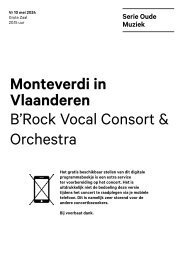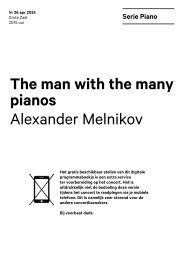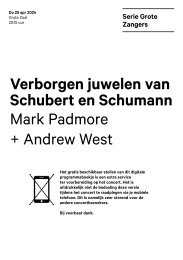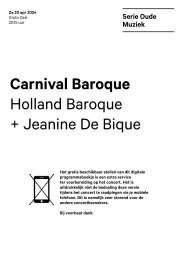Create successful ePaper yourself
Turn your PDF publications into a flip-book with our unique Google optimized e-Paper software.
Programme notes<br />
Taking the first step, playing the first note, or even writing the first line of this text can be a<br />
surprisingly overwhelming task. And just like that, opening a festival might feel like swimming<br />
in an ocean of choices. What could, or should, become the starting point of a journey?<br />
Unexpectedly, and fortunately, this wasn’t the case for us this time.<br />
Bringing together this monumental trinity<br />
of works for our opening concert was a<br />
momentous decision, but it was made without<br />
the slightest hesitation. There was an uncanny<br />
feeling that these pieces demanded to be<br />
played together—something we couldn’t<br />
ignore nor resist.<br />
In a way, considering their nature and<br />
character, this couldn’t be more fitting. These<br />
three pieces are wilful, uncompromising,<br />
and unconventional masterworks. There is<br />
something intimidating, unyielding, and nonnegotiable<br />
about their pure, potent shapes<br />
and blazing clarity of expression. We approach<br />
them with awe and fervour.<br />
The Cello Sonata of Ludwig van Beethoven<br />
Occupying the centre stage, Beethoven’s<br />
last cello sonata is a decisive and concise<br />
work, gigantic in its impact and meaning<br />
rather than in its scale. The movements are<br />
remarkably compact and reduced and could<br />
have felt, perhaps, somewhat ‘primitive’ if<br />
not for their astonishing concentration and<br />
precision. In turn, the high pathos and energy<br />
of the piece are kept in perfect balance by its<br />
functional, almost formulaic constructions. It<br />
is an ultimately transcendental work: at every<br />
moment and in every note, there is a feeling of<br />
unknown energy and freshness, of unattainable<br />
purity and condensed meaning. Most<br />
interestingly, these consummate qualities may<br />
strike one as somewhat menacing, extreme,<br />
almost supernatural, and ultimately inhuman. It<br />
is its otherworldly radiance that makes it both<br />
so attractive but also a bit inaccessible.<br />
The Violin Sonata of Dmitri Shostakovich<br />
Remarkably for the late Shostakovich, there<br />
is incredible directness in his Violin Sonata.<br />
In his final years, the composer, preoccupied<br />
with transience, mastered muted and veiled<br />
tones. <strong>Music</strong>al mists and shadows allowed<br />
him to approach his evasive subjects gently,<br />
as if trying to get closer to the mysteries<br />
of non-existence, remaining unnoticed and<br />
unrecognised. Yet, this kind of guardedness<br />
and secretiveness is hardly evident in Op.134.<br />
There is a spirit of decisive boldness in it,<br />
both confronting and unapologetic. Its clarity<br />
is most reminiscent of late Beethoven - in a<br />
similar way, the tremendous depth of feeling is<br />
matched here by great objectivity. Maybe this<br />
is why, paradoxically, this dark and desperate<br />
work doesn’t leave the listener in the dark; it<br />
lifts the spirit in a similar way Shakespeare’s<br />
tragedies do. Earlier in his life, Shostakovich<br />
created iconic film scores for Hamlet and King<br />
Lear, and one might feel that the Violin Sonata,<br />
one of his most ambitious and sophisticated<br />
works, draws from the same source of<br />
knowledge and inspiration.<br />
The Piano Sonata of Galina Ustvolskaya<br />
If concentration, precision, and boldness are<br />
the connecting thread in our opening program,<br />
5





